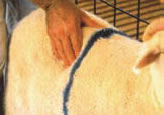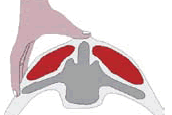|
Condition scoring is a process to assess the body reserves of a mature sheep. Condition scoring measures the tissue cover (fat and muscle) over the loin area. The animal is best examined in a race when it is standing and relaxed.
Condition scoring can be used to assess the average condition score of a mob or sometimes it is used to draft individual sheep in a mob so they can be managed in specific nutritional groups. About 25 to 50 sheep scored at random (from the middle of the mob) provides an accurate indication of the mob’s nutritional status.
Condition score is a useful tool for understanding the nutritional status of sheep because it more directly reflects the underlying changes in muscle and fat as the animal’s nutritional status changes.
Condition score (CS) is used across Victoria, Tasmania, South Australia and Western Australia to manage the nutritional status of adult breeding sheep. In New South Wales, fat score (FS) has also been adapted to assess the nutritional status of adult sheep, particularly in relation to flock reproduction targets. Fat scoring is described in tool 3.3 in Market Focused Lamb and Sheepmeat Production.
View the “How to condition score” video on www.lifetimewool.com.au by looking under the "Tools for Management" tab.
How to condition score
Source: the Lifetime Wool project (www.lifetimewool.com.au)
 |
Condition Scoring
The animal should be standing
in a relaxed position. It should
not be tense, crushed by other
animals or held in a crush.
If the animal is tense it is not
possible to feel the short ribs and
get an accurate condition score
|

|
|

Condition Score 1
|
Score 1-Backbone
The bones form an elevated narrow
ridge. Each vertebral process can be
felt easily as a bone under the skin.
There is only a very small eye muscle.
The sheep is strong but quite thin
(virtually unsaleable)
|
Score 1-Short Ribs
The ends of the short ribs are very obvious. It is easy to feel the squarish shape of the ends. Using fingers spread 1cm apart, it feels like the fingernail under the skin with practically no covering
|
|

Condition Score 2
|
Score 2-Backbone
The vertebral processes are elevated
but the points are rounded with muscle.
It is easy to press between each bone.
There is a reasonable eye muscle
(store condition ideal for wethers
and lean meat).
|
Score 2-Short Ribs
The ends of the short ribs are rounded but it is easy to press between them. Using fingers spread 0.5cm apart, the ends feel rounded like finger ends. They are covered with flesh but it is easy to press under and between them.
|
|

Condition Score 3
|
Score 3-Backbone
The spinal processes are only
slightly elevated above a full eye
muscle. It is possible to feel each
rounded bone but not to press
between them. (Forward store
condition ideal for most lamb
markets now. No excess fat).
|
Score 3-Short Ribs
The ends of short ribs are well rounded and filled in with muscle. Using 4 fingers pressed tightly together, it is possible to feel the rounded ends but not between them. They are well covered and filled in with muscle.
|
|

Condition Score 4
|
Score 4-Backbone
It is possible to feel most spinal
processes with pressure. The back
bone is a smooth slightly raised
ridge above full eye muscles and
the skin floats over it.
|
Score 4-Short Ribs
It is only possible to feel or sense one or two short ribs and only possible to press under them with difficulty. It feels like the side of the palm, where maybe one end can just be sensed.
|
|

Condition Score 5
|
Score 5-Backbone
The spine may only be felt (if at all)
by pressing down firmly between the
fat covered eye muscles. A bustle of
fat may appear over the tail (wasteful
and uneconomic).
|
Score 5-Short Ribs
It is virtually impossible to feel under the ends as the triangle formed by the long ribs and hip bone is filled with meat and fat. The short rib ends cannot be felt.
|
Note: One condition score is equivalent to 19% of the standard reference weight for a sheep. The table below summarises the weight of one condition score for different sized sheep.
| Standard weight |
40kg
|
50kg
|
60kg
|
70kg
|
| One condition score |
7.5kg
|
9.5kg
|
11.4kg
|
13.3kg
|
| |
|
|
|
|
Condition score recording sheet
Source: Lifetime Wool Project
Recording the condition score
Randomly score 25-50 sheep from the middle of the mob. Record the condition score of each sheep with an X on the chart. The middle score of the distribution is close to the average. In this example with 25 sheep, the median value is 3.0 but by using the chart you can see the average is just less than 3.0.
| Condition Score |
| |
|
|
|
|
|
|
|
|
| |
|
|
|
|
|
|
|
|
| |
|
|
|
|
|
|
|
|
| |
|
|
|
|
|
|
|
|
| |
|
|
|
X |
|
|
|
|
| |
|
|
|
X |
|
|
|
|
| |
|
|
X |
X |
|
|
|
|
| |
|
|
X |
X |
X |
|
|
|
| |
|
|
X |
X |
X |
|
|
|
| |
|
X |
X |
X |
X |
|
|
|
| |
X |
X |
X |
X |
X |
|
|
|
| |
X |
X |
X |
X |
X |
X |
|
|
| 1.0 |
1.5. |
2.0 |
2.5 |
3.0 |
3.5 |
4.0 |
4.5 |
5.0 |
Download the Condition Score Recording Sheet (52KB).
|